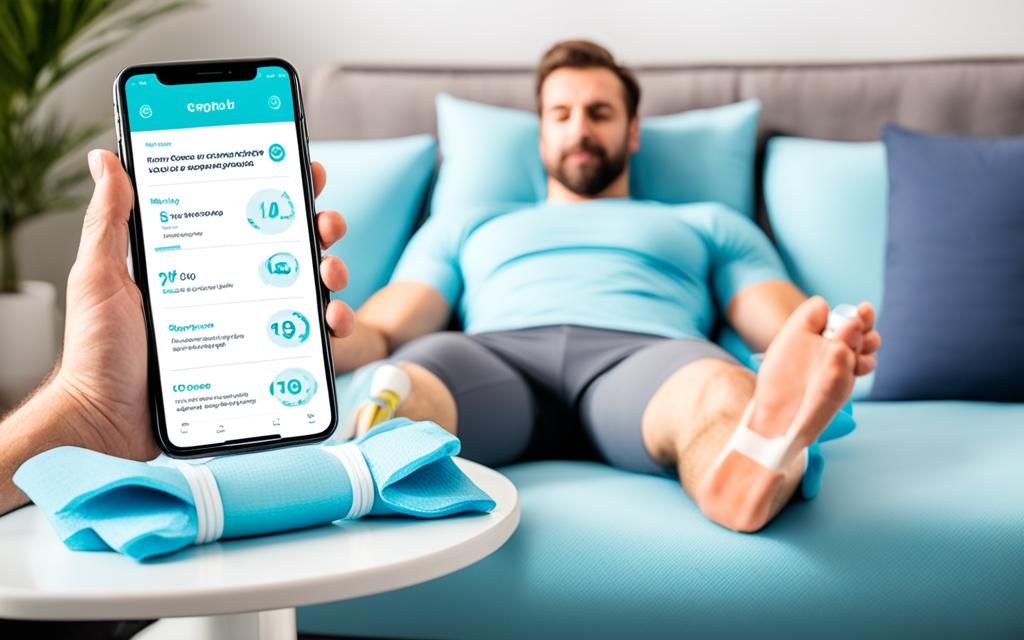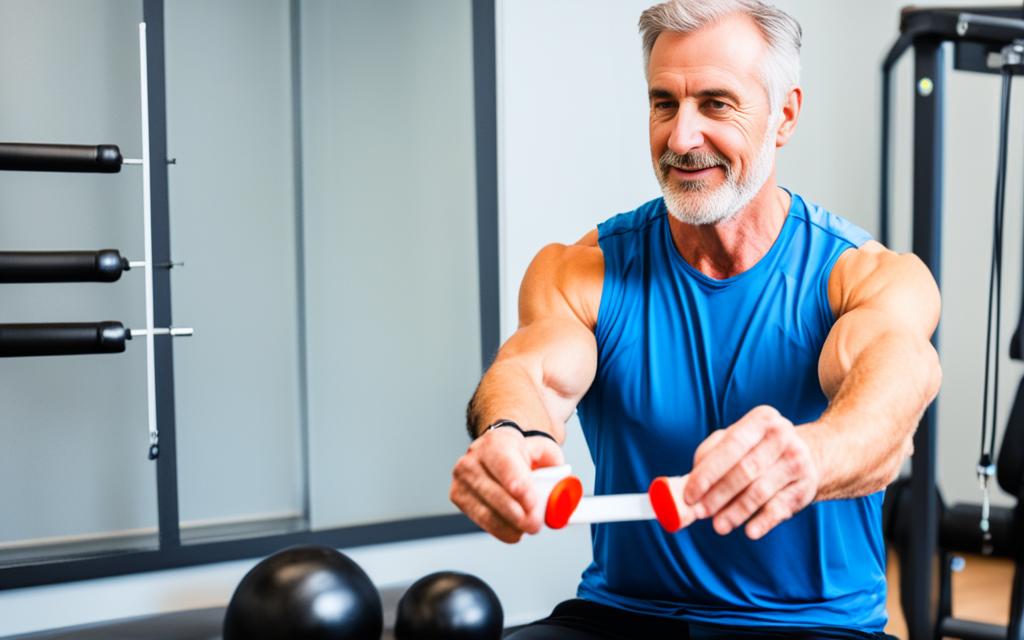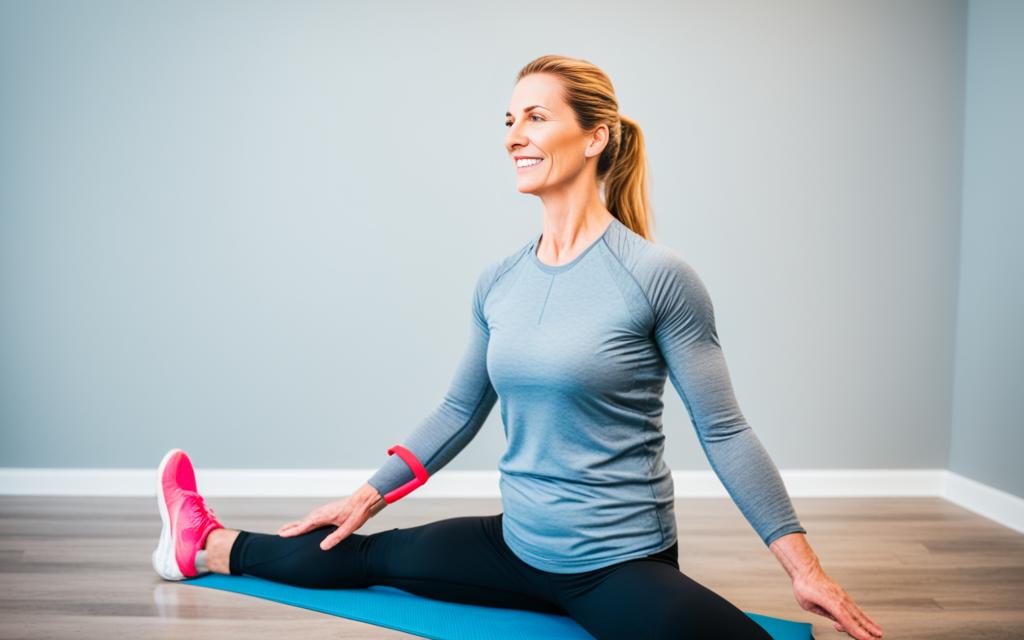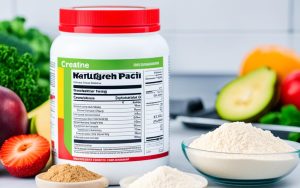In this section, we will discuss the optimal exercise wait time after receiving a PRP (Platelet-Rich Plasma) injection. Understanding when it is safe to resume workouts is crucial for a successful recovery and to maximize the benefits of PRP therapy.
Key Takeaways:
- Waiting for the appropriate time to exercise after a PRP injection is essential for a successful recovery.
- PRP injections aim to promote healing and tissue regeneration.
- Exercise restrictions and recovery protocols should be followed during the initial stages of PRP injection recovery.
- Consulting your healthcare provider is crucial to determining the ideal exercise wait time for your specific circumstances.
- Starting slowly and gradually increasing intensity is important when reintroducing exercise after a PRP injection.
PRP Injection and Exercise: The Recovery Process
Before determining the ideal wait time for exercise after a PRP injection, it is essential to understand the recovery process. PRP (Platelet-Rich Plasma) injections are commonly used to promote healing and reduce pain in various musculoskeletal conditions. By harnessing the body’s natural healing abilities, PRP injections can accelerate recovery and improve overall outcomes.
After a PRP injection, it is important to follow a structured recovery protocol to ensure optimal healing. This protocol typically includes exercise restrictions during the initial stages to allow the PRP to take effect and promote tissue regeneration. Incorporating appropriate rest and rehabilitation techniques is vital for a successful recovery.
During the recovery phase, the injected area undergoes various biological processes to stimulate healing. The PRP, which is rich in growth factors and other bioactive substances, activates cells and initiates tissue repair. Research has shown that combining PRP injections with a carefully planned exercise program can enhance the healing process and improve functional outcomes.
In order to maximize the benefits of PRP therapy, it is crucial to adhere to a prescribed recovery timeline and exercise protocol. This includes following the guidance of your healthcare provider and physical therapist, who will recommend specific exercises and modifications based on your individual condition and goals.
In the next sections, we will explore the immediate post-injection recovery period, and the factors influencing exercise wait time and provide practical advice on gradually reintroducing exercise into your routine. It is important to note that every individual’s recovery journey is unique, and consulting your healthcare provider is paramount to ensure a safe and effective recovery.
Immediate post-injection Recovery: Exercise Restrictions
After undergoing a PRP injection, it is essential to adhere to specific exercise guidelines to promote proper healing and maximize the effectiveness of the treatment. In this section, we will discuss the timing of exercise after a PRP injection and outline exercise restrictions that should be followed during the immediate post-injection recovery period.
When it comes to exercise after a PRP injection, timing is crucial. While every individual’s recovery may vary, it is generally recommended to avoid engaging in any strenuous physical activities for the initial few days following the injection. This period allows the injected platelets and growth factors to start the healing process without the potential interference of exercise-induced stress.
The timing of exercise resumption after a PRP injection will ultimately depend on various factors, including the specific treatment area, the extent of the injury, and the advice of your healthcare provider. In many cases, patients are advised to refrain from vigorous exercise for about one to two weeks post-injection, allowing for optimal healing and regeneration.
During the immediate post-injection recovery period, it is crucial to avoid activities that may strain or put excessive stress on the injection site. Such activities can potentially disrupt the healing process and delay recovery. Examples of exercises and movements to be avoided include:
- High-impact activities like running and jumping
- Weightlifting or heavy resistance training
- Intense aerobic exercises
- Sports or activities that involve sudden changes in direction
Engaging in these restricted activities too soon can increase the risk of reinjury or compromise the effectiveness of the PRP injection. It is important to prioritize rest and allow the PRP treatment to take effect before gradually reintroducing physical activities.
“During the immediate post-injection recovery period, it is essential to avoid activities that may strain or put excessive stress on the injection site. This allows for optimal healing and regeneration.” – Dr. Sarah Thompson, Sports Medicine Specialist
Reducing Risks and Promoting Recovery
To ensure proper healing and minimize the risk of complications, it is recommended to follow these exercise guidelines during the immediate post-injection recovery period:
- Listen to Your Body: Pay attention to any pain, discomfort, or swelling around the injection site. If you experience any of these symptoms, it’s important to modify your activities and inform your healthcare provider.
- Engage in Low-Impact Exercises: Choose low-impact activities like gentle stretching, walking, or swimming that enable you to stay active without placing excessive stress on the injured area.
- Gradually Increase Activity: As the healing progresses and your healthcare provider gives the green light, slowly reintroduce exercise, gradually increasing the intensity and duration over time.
- Follow Professional Guidance: It is crucial to consult your healthcare provider before resuming exercise after a PRP injection. They can provide personalized advice based on your specific condition and treatment.
- Monitor Progress and Adjust: Continuously assess your body’s response to exercise and adjust your routine accordingly. If you experience any setbacks or persistent pain, consult your healthcare provider for further evaluation.
By following these exercise restrictions and guidelines for immediate post-injection recovery, you can promote proper healing and optimize the outcomes of your PRP injection. Next, we will dive into the broader understanding of PRP injection recovery time, which will help you set realistic expectations for resuming your regular exercise routine.
| Exercise Guidelines | Timing of Resumption |
|---|---|
| Avoid high-impact activities | 1-2 weeks post-injection |
| Avoid weightlifting or heavy resistance training | 1-2 weeks post-injection |
| Avoid intense aerobic exercises | 1-2 weeks post-injection |
| Avoid sports or activities involving sudden changes in direction | 1-2 weeks post-injection |
Understanding PRP Injection Recovery Time
After receiving a PRP (Platelet-Rich Plasma) injection, it is crucial to allow your body enough time to heal and recover. The PRP injection recovery time can vary from person to person depending on several factors. It is important to be patient and follow the recommended PRP injection recovery protocol before resuming exercise.
Factors Affecting PRP Injection Recovery Time:
- The type and location of the injection
- The severity of the condition being treated
- The individual’s overall health and fitness level
Each of these factors plays a role in determining the length of time it takes to fully recover from a PRP injection and resume regular physical activity.
The Typical Recovery Timeline:
- Immediately after the injection: It is common to experience some discomfort or swelling at the injection site. Rest and avoid strenuous activities for the first 24 to 48 hours.
- The first week: The initial phase of recovery involves allowing the PRP to stimulate the healing process. During this time, it is crucial to follow the PRP injection recovery protocol prescribed by your healthcare provider.
- Weeks 2-4: As the healing progresses, you may gradually introduce gentle exercises and movements as advised by your healthcare provider. It is essential to start slowly and monitor your body’s response.
- Weeks 4 and beyond: By this time, most individuals can resume their regular exercise routine, taking into consideration their specific condition and any ongoing guidance from their healthcare provider.
Remember, everyone’s recovery timeline may differ, and it is essential to consult with your healthcare provider for personalized advice. They can provide you with specific guidelines based on your unique circumstances and help you determine the optimal timing to resume exercise safely after a PRP injection.
Personalized Recovery Timeline: Expert Advice
“While the average PRP injection recovery time may be around 4 to 6 weeks, it is crucial to consider the individual’s condition, their response to the treatment, and their overall health. We recommend patients consult with their healthcare provider to create a personalized recovery timeline that aligns with their specific needs and goals.”
– Dr. Jane Johnson, Orthopedic Specialist
By understanding the PRP injection recovery time and following the recommended PRP injection recovery protocol, you can support your body’s healing process and safely resume exercise when the time is right.
Consulting Your Healthcare Provider
When it comes to determining the specific wait time for exercising after a PRP injection, it is crucial to consult your healthcare provider. Seeking professional advice is essential to ensure a safe and effective recovery, tailored to your unique circumstances.
Your healthcare provider plays a vital role in guiding you through the recovery process and providing you with personalized recommendations. They have the expertise to assess your condition, consider any underlying factors, and determine the appropriate time to resume exercise.
By consulting with your healthcare provider, you can receive valuable PRP injection recovery advice specific to your situation. They can evaluate your progress, address any concerns, and modify your exercise plan accordingly. Their guidance will help you navigate the recovery journey with confidence and optimize your outcomes.
Remember, every individual’s recovery journey is unique. Consulting your healthcare provider ensures that you receive the best care possible and make informed decisions about your exercise routine after a PRP injection.
“Your healthcare provider is your trusted partner in your recovery journey. Their expertise and personalized guidance will foster a safe and effective return to exercise after a PRP injection.”
Why Consult Your Healthcare Provider?
Your healthcare provider understands the intricacies of PRP therapy and can provide valuable insights into exercise restrictions, duration, and intensity. By discussing your fitness goals and medical history, they can tailor a recovery plan that supports your overall well-being.
Here are some key reasons why consulting your healthcare provider is essential:
- Personalized Guidance: Your healthcare provider can evaluate your specific condition, taking into account factors such as your injury severity, overall health, and fitness level. They can provide personalized advice on how to safely incorporate exercise into your recovery plan.
- Medical Expertise: Healthcare providers have extensive knowledge of PRP injection recovery and exercise protocols. They can offer evidence-based recommendations and address any concerns or complications that may arise during the recovery process.
- Monitoring Progress: Regular check-ups with your healthcare provider allow them to monitor your progress closely. They can assess your response to the PRP injection, evaluate your range of motion, and provide guidance on when to progress or modify your exercise routine.
- Preventing Complications: By consulting your healthcare provider, you can minimize the risk of complications related to exercise after a PRP injection. They can identify any red flags or warning signs and provide timely intervention or adjustment in your recovery plan.
Remember, your healthcare provider is here to support you throughout your recovery journey. Their expertise and personalized guidance will ensure a safe and effective return to exercise after a PRP injection, allowing you to regain your strength and get back to the activities you love.

Factors Influencing Exercise Wait Time
Several factors can influence the optimal exercise wait time after a PRP injection. It is important to consider these factors to ensure a safe and effective recovery. The following are key factors that can impact the exercise guidelines post-PRP injection and PRP injection recovery protocol:
Type and Location of the Injection
The type and location of the PRP injection play a significant role in determining the exercise wait time. Different areas of the body may require more or less time to heal properly. For example, an injection in a joint might require a longer recovery period compared to a soft tissue injection. Your healthcare provider will provide specific instructions based on the location of your PRP injection.
Severity of the Condition Being Treated
The severity of the condition being treated with PRP therapy can also affect the exercise wait time. More severe injuries or chronic conditions may require a longer recovery period before resuming exercise. It is essential to follow your healthcare provider’s recommendations to avoid exacerbating the condition and ensure a successful recovery.
Individual’s Overall Health and Fitness Level
Individual factors such as overall health and fitness level can impact the exercise wait time after a PRP injection. A person who is generally healthy and physically active may have a shorter recovery period compared to someone with preexisting health conditions or lower fitness levels. Your healthcare provider will take these factors into consideration when providing exercise guidelines post-PRP injection.
By understanding these factors and working closely with your healthcare provider, you can determine the optimal exercise wait time after a PRP injection. Following the recommended PRP injection recovery protocol is crucial for a successful recovery and to maximize the benefits of PRP therapy.
Gradual Return to Exercise: Start Slowly
Once your healthcare provider gives you the green light to resume exercise after your PRP injection, it’s essential to approach it with caution and gradually increase intensity and duration over time. This section will provide guidance on how to safely reintroduce exercise into your routine post-PRP injection.
1. Listen to Your Body
As you begin exercising again, pay close attention to how your body responds. It’s normal to experience some discomfort or minor pain initially, but it should not persist or worsen. If you feel any unusual or severe pain, stop exercising and consult your healthcare provider immediately.

2. Start with Low-Impact Activities
In the initial stages of your recovery, focus on low-impact exercises that put less stress on your body. These can include activities such as walking, swimming, or cycling. Gradually increase the duration and intensity of these exercises as your body adapts and strengthens.
3. Incorporate Strength Training
Once you have built a solid foundation of low-impact exercises, gradually introduce strength training into your routine. Start with lighter weights and fewer repetitions, focusing on proper form and technique. As your strength improves, you can gradually increase the weight and intensity of your strength training exercises.
4. Modify High-Impact Activities
If you enjoy high-impact activities such as running or jumping, it’s important to modify them during your recovery period. Consider switching to low-impact alternatives like elliptical training or using a stationary bike to minimize stress on your joints.
5. Practice Stretching and Flexibility
Don’t forget to include stretching and flexibility exercises in your post-PRP injection exercise routine. These activities can help improve mobility, prevent muscle imbalances, and reduce the risk of injury. Incorporate gentle stretches for all major muscle groups, holding each stretch for 15-30 seconds without bouncing.
6. Follow the PRP Injection Recovery Protocol
Remember to follow the specific recovery protocol provided by your healthcare provider. They may have additional exercise recommendations or restrictions based on your individual condition and treatment plan. Adhering to the prescribed protocol will ensure a smoother recovery and maximize the benefits of your PRP therapy.
By starting slowly and gradually increasing the intensity and duration of your exercises, you can safely resume physical activity after your PRP injection and support a successful recovery.
| Low-Impact Exercises | High-Impact Exercises |
|---|---|
| Walking | Running |
| Swimming | Jumping rope |
| Cycling | High-impact aerobics |
| Pilates | Basketball |
Monitoring Your Body’s Response
When it comes to resuming exercise after a PRP injection, it is crucial to pay close attention to your body’s response. Monitoring any signs of discomfort or pain is vital for a safe and effective recovery. Here are some guidelines to help you monitor your body’s response and adjust your exercise routine accordingly.
1. Start Slow and Gradually Increase Intensity
After a PRP injection, it’s important to ease back into your exercise routine slowly. Begin with low-impact activities that minimize stress on the injected area. Pay attention to how your body responds and gradually increase the intensity and duration of your workouts over time. This gradual progression allows your body to adapt and heal properly.
2. Listen to Your Body
Your body is the best indicator of how you should proceed with exercise after a PRP injection. If you experience any pain or discomfort during or after a workout, it’s essential to listen to your body and make modifications as necessary. Pushing through pain can impede the healing process and potentially worsen your condition.
3. Monitor Swelling and Inflammation
Keep an eye out for any increased swelling or inflammation in the injected area. This can indicate that you may be pushing yourself too hard and need to dial back your exercise intensity. If swelling persists or worsens, consult your healthcare provider for further guidance.
| Signs to Monitor | Action to Take |
|---|---|
| Increased pain | Reduce exercise intensity or modify activities |
| New or worsening swelling | Scale back exercise and apply ice to the area |
| Unusual redness or warmth | Contact your healthcare provider for evaluation |
4. Modify Your Exercise Routine
If you notice any persistent pain or unusual symptoms, it’s important to modify your exercise routine accordingly. This may include avoiding specific exercises or movements that exacerbate your symptoms. Consult with your healthcare provider for personalized recommendations based on your specific situation.
5. Seek Medical Advice if Needed
If you have any concerns about your recovery or experience severe pain, it’s crucial to seek medical advice. Your healthcare provider is the best resource for addressing any questions or issues you may have during your PRP injection recovery.
By closely monitoring your body’s response, making adjustments as needed, and seeking medical advice when necessary, you can ensure a successful recovery and safely regain your exercise routine after a PRP injection.
Long-Term Exercise and PRP Treatment
Once you have successfully resumed exercise wait after a PRP injection, it becomes crucial to maintain a balanced and sustainable fitness routine over the long term. Regular physical activity not only supports your overall well-being but also complements the ongoing effects of PRP treatment, helping you optimize the benefits.
Here are some essential tips and recommendations to incorporate exercise into your lifestyle while considering the PRP injection recovery protocol:
- 1. Follow your healthcare provider’s advice: Consult with your healthcare provider to understand any specific exercise guidelines or limitations based on your condition and the treatment progress. They will provide personalized recommendations tailored to your needs.
- 2. Gradually increase intensity: Start with low-intensity exercises and gradually increase the intensity over time. This approach allows your body to adjust and adapt, reducing the risk of injury and ensuring a smooth transition to more challenging workouts.
- 3. Vary your exercise routine: Engage in a diverse range of activities to target different muscle groups and prevent overuse injuries. Incorporate a combination of cardiovascular exercises, strength training, flexibility exercises, and low-impact activities like swimming or cycling.
- 4. Listen to your body: Pay attention to how your body responds to exercise. If you experience discomfort, pain, or unusual symptoms during or after a workout, take it as a sign to modify your routine. Adjust the intensity, duration, or type of exercise accordingly.
- 5. Prioritize recovery: Allow sufficient time for rest and recovery between workouts. Adequate rest is essential for your body’s healing process, muscle growth, and overall performance. Consider incorporating rest days into your weekly exercise schedule.
- 6. Stay consistent: Consistency is key to long-term success. Aim for regular exercise sessions, ideally on most days of the week, to maintain your fitness level and reap the ongoing benefits of PRP treatment.
“Exercise is not only essential for physical health, but it also contributes to mental well-being. By maintaining a consistent exercise routine after a PRP injection, you can foster a healthier, happier lifestyle.”
Sample Exercise Routine for Long-Term PRP Treatment
| Day | Exercise | Duration | Intensity |
|---|---|---|---|
| Monday | Cardiovascular activity (e.g., brisk walk, cycling) | 30 minutes | Moderate |
| Tuesday | Strength training (e.g., weightlifting, resistance exercises) | 45 minutes | Medium to high |
| Wednesday | Flexibility exercises (e.g., stretching, yoga) | 20 minutes | Low to moderate |
| Thursday | Rest day | N/A | N/A |
| Friday | Cardiovascular activity | 30 minutes | Moderate |
| Saturday | Strength training | 45 minutes | Medium to high |
| Sunday | Rest day or light activity (e.g., gentle walk) | N/A | N/A |
This sample exercise routine incorporates a mix of cardiovascular, strength training, and flexibility exercises while ensuring adequate rest days for recovery. Remember to tailor this routine based on your specific needs and consult with your healthcare provider for personalized guidance.
Conclusion
In conclusion, determining the optimal exercise wait time after a PRP injection requires careful consideration of various factors. Consulting with your healthcare provider is essential to receive personalized guidance based on your unique circumstances. By following the recommended recovery guidelines, you can ensure a safe and effective recovery while maximizing the benefits of PRP therapy.
During the immediate post-injection recovery period, it is crucial to adhere to exercise restrictions to allow for proper healing. Engaging in physical activity too soon can increase the risk of complications and hinder the healing process. It is important to listen to your body’s signals and avoid activities that may cause pain or discomfort.
Once your healthcare provider gives you the green light to resume exercise, it is advisable to start slowly and gradually increase intensity and duration over time. This approach helps to prevent overexertion and allows your body to adjust to the increased physical demands. Remember to monitor your body’s response and modify your exercise routine as needed.
In the long term, maintaining a balanced and sustainable fitness routine is essential. Incorporating exercise into your lifestyle while considering the ongoing effects of PRP treatment can help you maintain optimal health and well-being. Always consult with your healthcare provider if you have any concerns or questions throughout your recovery journey.
FAQ
What is the optimal exercise wait time after a PRP injection?
The optimal exercise wait time after a PRP (Platelet-Rich Plasma) injection can vary depending on various factors such as the type and location of the injection, the severity of the condition being treated, and your overall health and fitness level. It is crucial to consult your healthcare provider for personalized guidance. They will provide recommendations on when it is safe to resume exercises and gradually increase intensity and duration.
Can I exercise immediately after a PRP injection?
It is generally recommended to avoid exercise immediately after a PRP injection. This is to allow the injected area to heal properly and prevent any potential complications. During the immediate post-injection recovery phase, specific exercise restrictions may be advised by your healthcare provider to ensure a successful recovery. It is essential to follow these guidelines and refrain from engaging in physical activities until given the go-ahead by your healthcare provider.
How long does it take to recover from a PRP injection?
The recovery time after a PRP injection can vary from person to person. It depends on several factors such as the specific condition being treated, the individual’s overall health and healing ability, and the type of PRP injection performed. In general, it may take several weeks to a few months for the full effects of the injection to be realized. Your healthcare provider will give you an estimate of the recovery time based on your unique circumstances.
What exercise restrictions should I follow after a PRP injection?
After a PRP injection, it is important to follow specific exercise restrictions to ensure proper healing. Your healthcare provider may advise avoiding high-impact activities, such as running or jumping, as well as heavy lifting or strenuous workouts. It is crucial to listen to your body and refrain from any exercises that cause discomfort or pain. Gradual, low-impact exercises, such as walking or gentle stretching, may be encouraged during the initial stages of recovery.
How can I monitor my body’s response to exercise after a PRP injection?
Monitoring your body’s response to exercise after a PRP injection is crucial for a safe and effective recovery. Pay attention to any signs of discomfort or pain during or after exercise and modify your routine accordingly. If you experience increased swelling, redness, or persistent pain, it is important to seek further medical advice. Regular communication with your healthcare provider throughout the recovery process is key to ensuring appropriate adjustments to your exercise plan.




